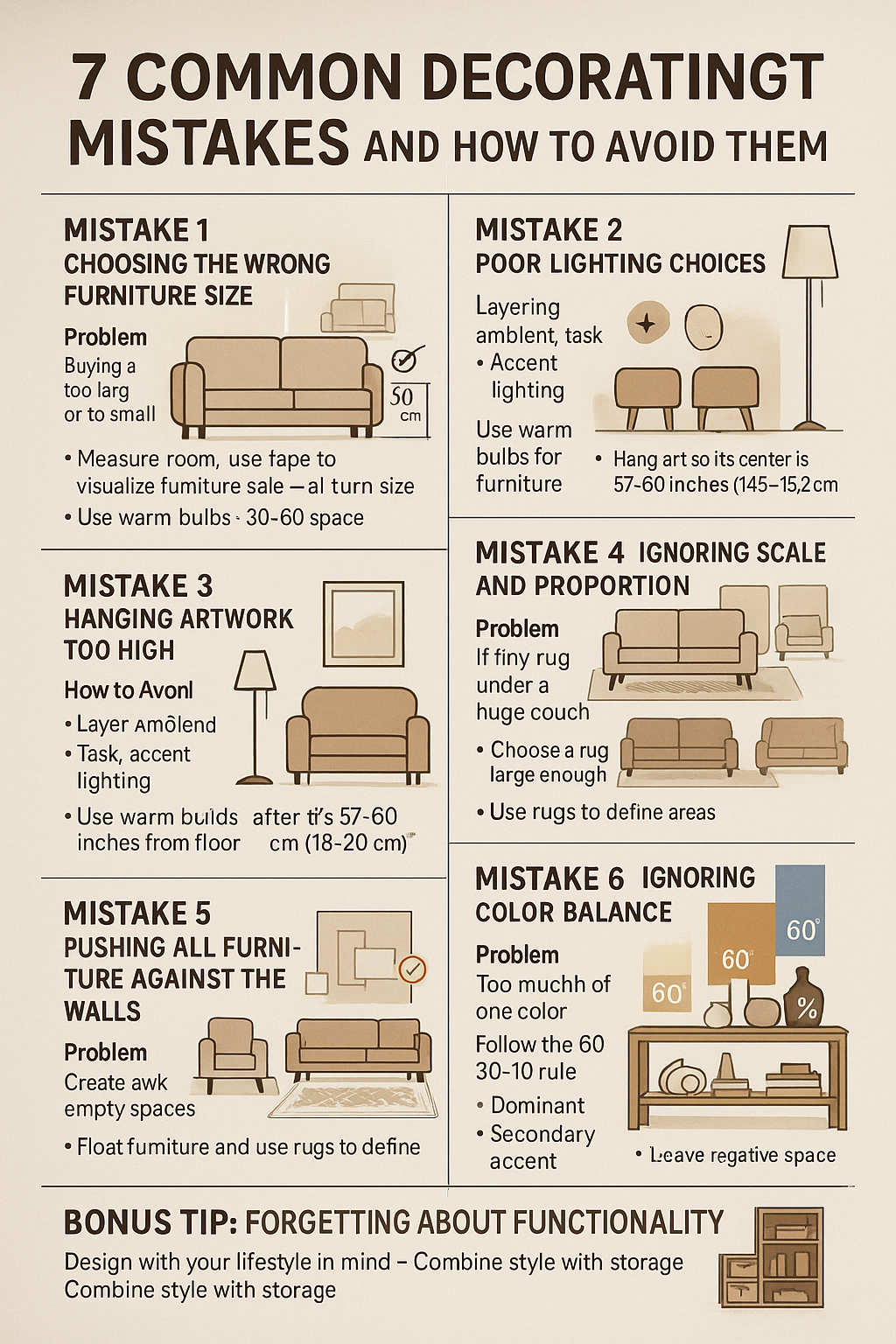Decorating your home is exciting, but it’s easy to fall into common pitfalls that can make a space feel awkward or less functional. Whether you’re moving into a new home or updating your current one, avoiding these mistakes will help you create a more cohesive, comfortable, and beautiful space.
Mistake 1: Choosing the Wrong Furniture Size
The Problem
Many people buy furniture that’s either too big or too small for their space. Oversized sofas can overwhelm small rooms, while tiny pieces can get lost in large, open spaces.
How to Avoid It
- Measure the room before buying.
- Use painter’s tape on the floor to visualize the size of furniture.
- Leave at least 30 inches (76 cm) of walking space around furniture.
Mistake 2: Poor Lighting Choices
The Problem
Relying on a single overhead light makes a room feel flat and uninviting.
How to Avoid It
- Layer your lighting:
- Ambient: Main ceiling lights.
- Task: Reading lamps, under-cabinet kitchen lights.
- Accent: Decorative lighting like wall sconces or LED strips.
- Use warm bulbs for a cozy feel and cooler tones for workspaces.
Mistake 3: Hanging Artwork Too High
The Problem
Artwork that’s too high can feel disconnected from the rest of the decor.
How to Avoid It
- Hang art so the center is 57 to 60 inches (145–152 cm) from the floor, which is average eye level.
- When placing art above furniture, keep it 6 to 8 inches (15–20 cm) above the top.
Mistake 4: Ignoring Scale and Proportion
The Problem
Combining mismatched proportions — like a tiny rug under a huge couch — makes a space feel unbalanced.
How to Avoid It
- Choose a rug large enough that at least the front legs of the furniture sit on it.
- Mix furniture of different heights thoughtfully to add interest while maintaining balance.
Mistake 5: Pushing All Furniture Against the Walls
The Problem
This creates awkward empty spaces in the center of the room and can feel impersonal.
How to Avoid It
- Float furniture away from walls to create conversation zones.
- Use area rugs to define different functional spaces within a room.
Mistake 6: Ignoring Color Balance
The Problem
Using too much of one color or clashing shades can overwhelm the senses.
How to Avoid It
- Follow the 60-30-10 rule:
- 60% dominant color (walls, large furniture)
- 30% secondary color (rugs, curtains)
- 10% accent color (pillows, decor)
- Use neutral bases and add color through accessories.
Mistake 7: Overcrowding with Accessories
The Problem
Too many decorative items make a space look cluttered instead of styled.
How to Avoid It
- Use the rule of three: group items in odd numbers for visual interest.
- Rotate accessories seasonally rather than displaying everything at once.
- Leave negative space to let key pieces stand out.
Bonus Tip: Forgetting About Functionality
A beautiful room that isn’t functional quickly becomes frustrating.
How to Avoid It
- Design with your lifestyle in mind: prioritize comfort, flow, and daily needs.
- Combine style with storage using furniture like ottomans with hidden compartments or bookshelves that display and organize.
Final Thoughts: Design with Purpose
Avoiding these common decorating mistakes will make your home more comfortable, balanced, and stylish. Good design isn’t just about following trends—it’s about creating spaces that feel right for you. Plan carefully, measure, and don’t be afraid to rearrange until everything feels just right.
